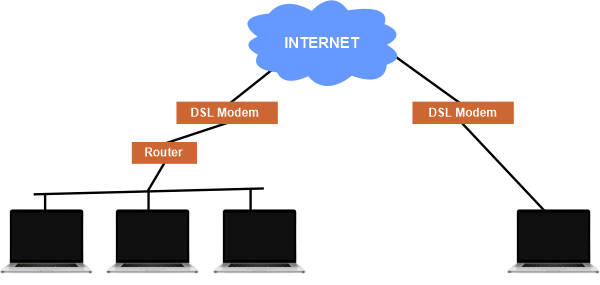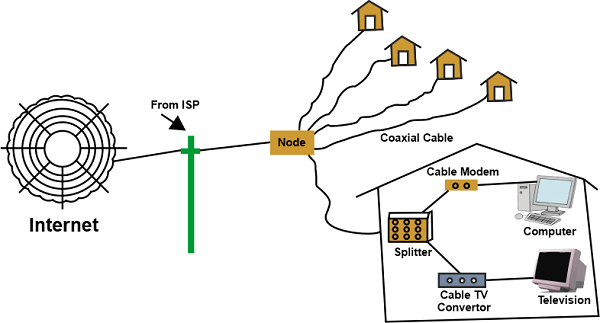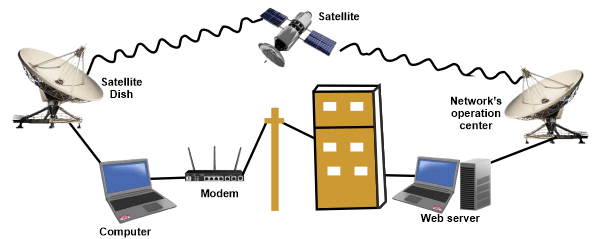Types of Internet ConnectionIn this article, we will understand the types of Internet connection. What is Internet Connection?A user can connect to the Internet either by dialing into an ISP's computer or by directly connecting to the ISP. A dial-up connection is the one you initiate by dialing into a modem over a telephone link whereas a direct connection is a continuous connection to an ISP through a dedicated phone line. The various types of Internet connections are:
The DSL, Cable TV Internet, Satellite Internet and wireless Internet connections are used for providing high speed or broadband Internet access. DIAL-UP CONNECTIONA dial-up connection is one of the most common types of Internet connection offered by ISPS. This connection uses a telephone line to connect your computer to the Internet. In order to access using such a connection, a hardware device known as a modem is needed. A modem acts as an interface between your computer and a telephone line A communication program (such as Dial Up Networking) instructs the modem to place a telephone call to a specific phone number provided by an ISP, establish a connection and then connect your computer to the Internet. In dial-up connection, a connection is not always on. You connect only when you want to access the services provided by the Internet and when you are finished using it just disconnect. 
The dial-up connection uses either the SLIP (Serial Line Internet Protocol) or PPP (Point to Point Protocol) protocols. However, most of the dial up connections are PPP protocol. Most ISPs support modems at a speed upto 56 kbps, so these basically used to read Emails and for Internet browsing. However, this type of connection has problems with video connections, high speed gaming and multimedia intensive websites. While using a dial up connection to access the Internet, you cannot talk on the phone. Thus a dial-up connection does not allow simultaneous talking and Internet access. Advantages of Dial-up Connection:
Disadvantages of Dial-up connection:
ISDN, TI AND T3ISDN was one of the first widely available truly digital services that stands for Integrated Services Digital Network. Like a dial-up connection, it also establishes a connection to your ISP over a phone line when required. However, unlike dial-up connection it uses an upgraded phone line which carries the digital signals instead of analog signals to provide fast internet access as well as regular voice calls simultaneously. It also provides an interface for connecting other devices such as fax machines, video phones etc. ISDN services are generally delivered in one of two techniques:
Basic Rate Interface: A BRI ISDN service consists of three distinct channels on a single ISDN line: two 64 Kbps B (Bearer) channels and one 16 Kbps D (Delta or Data) channels. The B channels can carry digital data, digitized voice, images, and video at a speed of 64 Kbps. By combining two B channels, a data transfer rate upto 128 kbps may be achieved. Besides this you can use each B channel for different purposes. One may be used to talk on the phone and the other may be used to access the Internet. However, this would temporarily limit your data transmission rate (bandwidth) to 64 Kbps as only one of the B channels is used for the Internet. The D channel is intended for the purpose of signaling and control, messaging, and network management. It can also be used for packet data transmission if not in use for signaling purposes. However, it does not have the voice capability. BRI is basically used for residential, small business and telecommuting applications that are not particularly bandwidth intensive. 
Primary Rate Interface PRI consists of 23 B channels plus one D channel. Both B and D channels operate at the speed of 64 Kbps making a total transmission rate of 1.544 Mpbs. This level of transmission rate is equivalent to that of T1 service. The individual B channels carry user information such as data, video, voice calls etc. and D channel is reserved for signaling information. In addition to T1 service, many telephone companies provide more data transmission speeds. T3 service is the one which uses 672 channels of 64 Kbps each making the total transmission speed of 44,736 Mbps. Several other fractional T services are also being provided between the levels of BRI and PRI as per the requirements of companies on the basis of their cost and needs. 
In order to connect your computer to the ISDN line, Terminal Adapters are used which are also known as ISDN modems. These modems come with phone jacks that allow you to plug in your telephone, computers, fax machine and video conferencing devices and use the ISDN line just like a normal phone line. Advantages of ISDN :
Disadvantages of ISDN :
DSL:DSL stands for Digital Subscriber Line which has emerged as a new Internet access technology that has brought high connection speeds to home users and business organizations. It is one of the most common forms of broadband connection as it provides fast Internet access over ordinary telephone lines. Several versions of DSL technology are available for home and business use which is the reason why it is also known as xDSL. Some of the most common DSL are:
All these differ depending on their upload and download speeds, bits transfer rate, levél of service, distance, and other factors. ADSL is the most popular and widely used high speed broadband connection that allows digital information to be sent at a very high speed over ordinary phone lines. Using this connection, the same phone line is splitted into two separate channels, one for data and one for voice. Thus it allows you to talk on the phone without disconnecting from the Internet. It is called asymmetric because the download speed is different from the upload speed. These speeds vary according to the location from the phone company. Some of the common download/upload speeds are 256 Kbps/128 Kbps, 512 Kbps/128 Kbps, 1Mbps/256 Kbps etc. The speed varies from 128 Kbps to 8 Mbps and upload speed ranges from 64 Kbps to 256 Kbps. 
SDSL is like ADSI. With the difference that in the former both the upload and download speeds are the same, In order to access the Internet using this connection, DSL modem is required for the home users and DSL router is required for connecting network computers. Advantages of DSL connection:
Disadvantages of DSL Connection:
CABLE TV INTERNET CONNECTIONCable TV Internet Connection is a high speed Internet connection service provided through existing Cable TV lines. You can watch TV in a normal manner and at the same time access the Internet. It is one of the most widely growing services in homes because of its affordability and ease of use. The cable TV lines use the coaxial cable which transfers data at much higher speed than common telephone lines. Its speed usually ranges from 256 Kbps to 1 Mbps In order to access this service, a cable modem is used which is provided by a Cable TV operator. A cable modem typically has two connections, one for the Internet service and other for the Cable TV signals. These modems are specially designed so that data transmission doesn't interfere with TV signals, making it possible to use both the services simultaneously. 
Cable TV Internet connections share a set amount of bandwidth with a group of customers. So the data transfer speed available to a user depends upon how many customers are using the Internet at the same time. Data transfer speeds can be extremely fast when only a few customers are online but it reduces drastically as the number of customers online increases. Cable TV Internet Services are far more available in residential communities than in business organizations. Advantages of Cable TV Internet Connection:
Disadvantages of Cable TV Internet Connection:
SATELLITE INTERNET CONNECTIONSatellite Internet Connection offers yet another option for accessing the Internet. It is the most expensive alternative for getting a high speed connection to the Internet. These connections are aimed for those remote areas where other Internet connections such as dial-up. ISDN, DSL cannot be used. Satellite Internet connection can either be a one way connection or a two way connection. In one way connection, you can only download data but in order to upload the data you need a dialup access through an ISP over telephone line. However, in a two way connection, downloads and uploads are done by the satellite without a need of dialup connection. 
In order to use this connection, you need a satellite dish, a coaxial cable and communication software. In addition, we may also need a phone line and a dial-up Internet connection if the user has to upload also. The download speed for these connections varies from 400 Kbps to 6 Mbps and the upload speed is limited upto a maximum of 128 Kbps. Advantages of Satellite Internet Connection:
Disadvantages of Satellite Internet Connection:
WIRELESS INTERNET CONNECTIONWith the recent advancement in wireless technology, the high speed Internet access is not limited to the desktop but it is now accessible on laptops, PDA's, mobiles also, Wireless Internet is the broadband Internet connection that use the radio frequency bands to connect to the Internet instead of using a telephone line or a cable network. This type of connection provides a very high speed, usually more than 10 Mbps and costs considerably less than the equivalent other wired versions. Its speeds range from 256 Kbps to 10 Mbps. It is possible to use this type of connection to transmit data over long distances. This type of connection is used by business travelers and persons who are away from home as long as they are within the network's coverage area. (wi-fi): A number of ISP's have placed 802.11b (wi-fi) network standards in public places such as hostels, coffee shops, airports, convention centers. These networks provide easy access to the Internet for anyone with a compatible device (e.g. Laptop or PDA). Bluetooth: It is also used for Internet access although it doesn't have the potential of wi-fi due to its limited distance. It was primarily promoted as it eliminated the need for cables between devices such as keyboard, computers, cellular phones, PDA's etc. The current standard allows upto 8 devices to be connected to it. Advantages of Wireless Internet Connection :
Disadvantages of Wireless Internet Connection:
Next TopicNoisy and Noiseless Channel
|
 For Videos Join Our Youtube Channel: Join Now
For Videos Join Our Youtube Channel: Join Now
Feedback
- Send your Feedback to [email protected]
Help Others, Please Share










